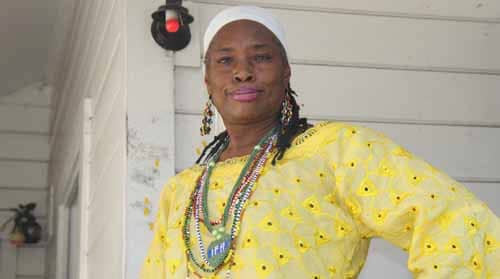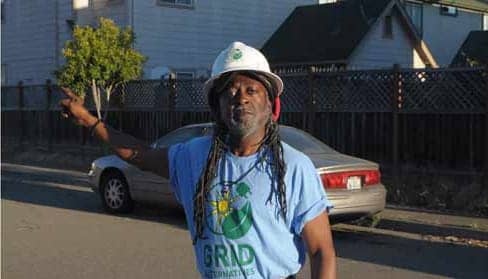by Eric K. Arnold
Oakland – For Adama Mosley, a resident of the West Oakland neighborhood known as Ghost Town, having solar panels installed on her home was “a dream come true.” Mosely had long been concerned about pollution from freeways and nearby brownfields (contaminated former industrial sites) contributing to the area’s high levels of asthma.
“I wanted to … do something to help clean up the neighborhood,” she said.

For a typical household, a complete solar system runs between $15,000 and $20,000, not including roof repairs, which can add another $10,000 to the cost. In Mosley’s neighborhood, the annual household median income is under $26,000, making solar all but impossible for most residents.
Solar seemed out of reach for Mosley until one day four years ago, when she was contacted by Jahahara Alkebulan-Ma’at, the Bay Area outreach coordinator for Grid Alternatives, a national nonprofit that does solar installations for low-income households.
Alkebulan-Ma’at says he often goes door-to-door in neighborhoods like Oakland’s Ghost Town, visiting residents to see if they qualify for Grid’s services. When he told Mosley she might be eligible for no-cost solar installation, she said she felt elated.
“I couldn’t believe that someone was actually doing something,” she recalled.
Unlike some of her neighbors, Mosley owned her own home, wasn’t facing foreclosure, and had a roof in good condition.
“Solar by itself won’t do it all,” Alkebulan-Ma’at explained. “We’re not going to put solar on a bad roof,” he said, noting that roof repairs are often needed in low-income communities.
Mosley diligently filled out the extensive paperwork required to become a Grid client and qualified for 100 percent financing, which the nonprofit cobbled together through a state rebate and a grant from a neighborhood group, the West Oakland Project Area Committee (WOPAC).
The power generated from her solar panels practically wiped out her monthly electricity bill – which dropped from about $350 a month to $5 a month. The cost savings help but, she adds, the big payoff for her was being able to reduce her carbon footprint and break “a circle of pollution.”
Mosley’s investment in solar panels reduces her electricity costs and comes from a source that doesn’t make the air in her neighborhood – which already has pollution problems – worse.
Clean energy can reduce pollution
In nearby East Oakland, the Hegenberger Corridor is a major transportation route – including diesel trucks – with over 218,000 vehicle trips a day. Combined with the area’s many industrial sites, residents here are burdened with high levels of pollution, contributing to soaring asthma rates that are as much as 200 percent higher than that for Alameda County.
The state EPA has placed East and West Oakland in the top 10 percent of the most polluted neighborhoods in the state, according to its Enviro-Screen tool. Residents in these communities, who are mostly Black, Latino and low-income, have fewer resources to deal with the pollution and, studies show, poor people pay a disproportionate amount of their income for utilities.
Reducing energy use through increased efficiency and getting more energy from cleaner, renewable sources does much to reduce pollution; it also can bring potential energy savings. Despite the benefits, minority and low-income residents face barriers in pursuing green energy options.
“Solar is not really affordable for folks who live in low-income communities,” explained Nehanda Imara, the East Oakland coordinator for Communities for a Better Environment, a non-profit environmental organization. “In deep East Oakland, I’ve seen one, maybe two houses with solar in the flatlands,” Imara said.
The state EPA has placed East and West Oakland in the top 10 percent of the most polluted neighborhoods in the state, according to its Enviro-Screen tool. Residents in these communities, who are mostly Black, Latino and low-income, have fewer resources to deal with the pollution and, studies show, poor people pay a disproportionate amount of their income for utilities.
In contrast to more affluent areas of Oakland or nearby Berkeley, rooftop solar installations are uncommon among East and West Oakland flatland residents. This isn’t surprising, considering that the median income in one heavily polluted corridor in the Hegenberger area is under $33,000 annually.
Vien Truong, environmental equity director for the Berkeley-based Greenlining Institute, which advocates for communities of color, says that “solar financing is out of reach” for low-income households, who often don’t qualify for home improvement loans. “Even if you own your own home, you can’t put that much investment” into solar energy, Truong says, an expense which, she notes, “takes years to recoup.”
Little help from the private sector
As rooftop solar has become more popular among homes and businesses, installation costs have fallen, decreasing by almost 30 percent since 2007. Yet even with the lower cost, solar is still too costly for many homeowners and business owners. And, while there has been a boom in solar installation companies in California in recent years, most do not target low-income households.
At a street fair this past July in North Oakland, A1 Sun, a Berkeley-based solar installation company whose motto is “power for the people,” greeted passers-by, extolling the benefits of solar power for homeowners. Yet when asked if A1 Sun’s services were available for low-income customers, CEO Larry Guistino bluntly stated that his company is too small to offer discounts, referring this reporter to larger companies like Sungevity and Solar City.
Even with the lower cost, solar is still too costly for many homeowners and business owners. And, while there has been a boom in solar installation companies in California in recent years, most do not target low-income households.
Will Craven, PR manager for Solar City’s Redwood City office, says that his company’s “entire mission is geared around making solar electricity as affordable as possible.” However, he conceded that the company does “not have a specific program for lower-income customers.”
‘Community building’ through renewable energy
Grid Alternatives is one of the few community organizations bringing solar to impoverished neighborhoods in Oakland. The nonprofit, which serves as program manager for the California Public Utilities Commission’s (CPUC) Single-family Affordable Solar (SASH) program, partners with municipalities, state agencies and affordable-housing developers such as Rebuild Together and Habitat for Humanity to offer solar installation for zero or little cost to qualified applicants. Homeowners like Mosley, whose income is less than 50 percent of the area household median, can qualify for no-cost installation, while those whose income is less than 80 percent of the area household median can qualify for substantially-reduced-cost installation.
According to Mary Biasotti, Grid’s Bay Area regional director, to date the organization has performed 171 installations in Oakland, mostly in West and East Oakland. That represents 376,000 kilowatts of solar, which she says is equivalent to the air quality benefits of planting 260,000 trees.
One of the challenges impacting wider adoption of solar power in low-income neighborhoods, Biasotti says, is convincing residents “they can be part of the green movement” – a privilege often perceived as reserved for affluent homeowners.
Sometimes, trying to sell low-income residents on solar means appealing to their pocketbooks.

More than just offering energy savings and utility relief, Alkebulan-Ma’at says, “the result of our work has been community-building.” Last year, he notes, Grid hosted a “solar-thon,” where over 300 volunteers participated and 10 installations were completed in one day. Besides helping to educate people about the benefits of renewable energy, he says, collective installations bring “positive energy to the community.”
Bayporte Village is one such community. Formerly known as Acorn Village, the West Oakland residential area was rife with open-air drug sales and other criminal activity, before being redeveloped by the East Bay Asian Local Development Corporation in 2000. Today, Bayporte Village is a quiet residential area with much lower crime.
Numerous studies have examined the impact of blight reduction on crime in neighborhoods. A 2011 study from the University of Michigan noted, “Beautifying and maintaining” vacant or blighted property “can be an effective crime prevention strategy.”
Bayporte’s 71 units were styled with a quaint, suburban look; solar panels installed by Grid Alternatives are visible from numerous rooftops throughout the development, serving as a symbol of the transformation of the neighborhood from a blighted area to a revitalized community.
Residential solar funding programs at capacity
Residential solar projects represent a win-win scenario for low-income residents: They save on energy costs, clean up the environment, add to property values, and can help communities shed the stigma of crime and blight.
In 2004, then-Gov. Schwarzenegger called for the construction of a million solar homes by 2017. In recent years, there has been a statewide push to bring affordable solar to low-income communities. In 2007, the CPUC launched the California Solar Initiative (CSI), which put $2.3 billion toward incentive programs and subsidies for solar installation for both single-family and multi-family homes, as well as businesses.
Yet while the CPUC touts CSI as a success – more than 135,000 solar installations have been completed since it launched – low-income communities of color continue to be underserved. Just 10 percent of the CSI budget went to low-income residential households and multi-family dwellings.
Residential solar projects represent a win-win scenario for low-income residents: They save on energy costs, clean up the environment, add to property values, and can help communities shed the stigma of crime and blight.
As of June 2013, CSI’s Multi-Family Affordable Solar Housing (MASH) program has completed fewer than 300 projects statewide – a drop in the bucket, compared to the millions of residents in multi-family housing. Almost 100 MASH projects are pending, and there is currently a waitlist for new applicants.
The SASH program’s residential solar component is also at capacity and, while it’s done 3,200 rooftop solar installations statewide in low-income households, about 500 applications have been wait-listed, Biasotti says.
Solving the energy equation
Energy advocates say significant challenges lie ahead if affordable renewable energy and widespread adoption of energy efficiency are to become a reality in low-income communities of color. By far the biggest hurdle to solar in these communities is the lack of home ownership; in multi-family residences, landlords typically don’t pay utility bills.
Programs like MASH and SASH were developed with good intentions but without “adequate resources to impact what’s needed,” said Al Weinrub of the Local Clean Energy Alliance, an Oakland-based grassroots advocacy organization.
In Vien Truong’s view, solving the energy equation for low-income communities is a complex problem that needs to be addressed with economic as well as environmental factors.
“How do we solve poverty and pollution at the same time?” she said. “How do we improve air quality in West Oakland?… How do we get [residents of these communities] into a career-track job?”
While there are no quick and easy answers to those questions, there are some encouraging signs. The SASH and MASH programs were recently extended for another five years, ensuring continued access to affordable solar for low-income communities, at half the cost of the previous initiative.
Programs like MASH and SASH were developed with good intentions but without “adequate resources to impact what’s needed.”
And the CPUC is addressing the multi-family residence issue by rolling out a pilot program in 2014 which provides incentives to landlords for energy efficiency measures – including rooftop solar, reducing asbestos and lead-based materials, and more efficient windows – as well as roof repairs for low-income families.
Even so, some advocates say, those programs won’t meet the needs of all the low-income residents who could benefit from them.
“If you’re going to have programs and policies that work, they’ve got to work for that segment of the population,” Weinrub said. “None of this stuff works unless the community is engaged.”
Bay Area writer Eric K. Arnold can be reached at easportski@sbcglobal.net. This story is reprinted from New America Media. This work was supported by a 2013 New America Media Energy Reporting Fellowship in collaboration with SoundVision Productions’ Burn: An Energy Journal.





